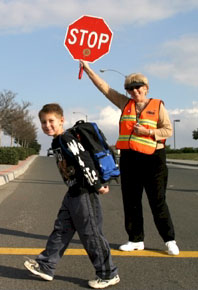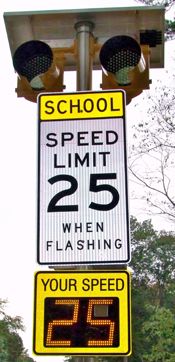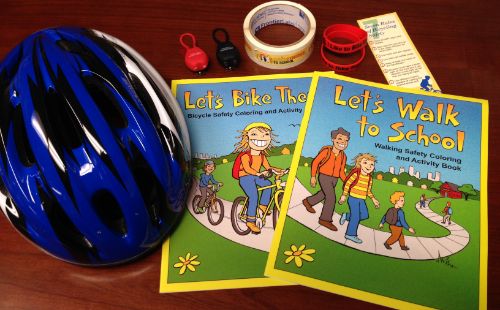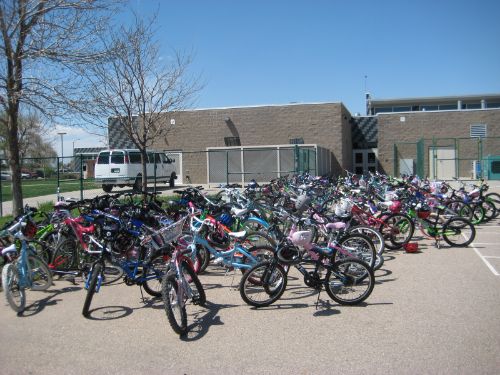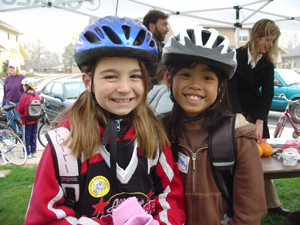What are the "6 Es"?#
Creating a safe route for every child requires attention to several categories of transportation services, described as the 6 Es:
- Education programs teach motorists, pedestrians and bicyclists how to share the road safely. The City leads educational programming for both kids and adults, including bicycle and pedestrian safety education during PE classes at schools and a Bicycle Friendly Driver course for adults.
- Enforcement enlists the help of local law enforcement to focus efforts in problem areas and increase community awareness of school safety issues. Enforcement also includes "passive controls" such as speed indicator signage to warn motorists if they are speeding through a school zone.
- Engineering tools include a variety of street design techniques that can reduce traffic volumes, decrease speed and improve safety. For youth, the focus is on safe facilities for bicycling and walking.
- Encouragement includes developing awareness and building enthusiasm for the many benefits of walking and bicycling to school.
- Evaluation focuses on surveys and audits to gain information from parents, students and the community on how to improve our programming and create safer, more comfortable conditions for biking and walking. Evaluation also includes annual traffic-safety data collection, analysis and reporting.
- Equity focuses on ensuring all families and youth of all ages and abilities have the same access to programming and safe facilities for biking and walking to school.
-
![]()
Teaching students and parents how to travel safely on local roadways is vital to keeping kids and families safe on their journey to and from school. Because not all roadways offer the same level of comfort and safety, education starts with teaching youth and parents how to choose a safe route to school.
Factors contributing to children's safety when walking include choosing multi-use paths along with streets with low-speed traffic, low traffic volumes, wide sidewalks and signalized street crossings. Many crossings near schools are staffed by trained crossing guards, adding to the level of safety. It's also safer to walk with a group rather than alone.
Factors contributing to children’s safety when bicycling include wearing a properly fitting helmet, biking with a group rather than alone and choosing a safe route that employs multi-use paths and, if necessary, streets with slower speeds and lower traffic volumes.
Children’s safety also depends on motorists’ awareness of pedestrians and bicyclists and cautious driving anywhere children may be present, including neighborhood streets, school areas and parks.
The City's Safe Routes to School program follows a prescribed plan known as the "School Rotation Schedule" to provide bicycle and pedestrian safety education to all students at public schools in Fort Collins. The program teaches bike-ped safety to 7,000 to 8,000 students annually.
-
![]()
Motor vehicles are the greatest danger to children's safety on their journeys to and from school.
Local law enforcement officers work to eliminate the following hazards to children traveling to school:
- Speeding in school zones
- Illegal passing of school buses
- Not yielding to pedestrians in crosswalks
- Unsafe driving near bicyclists
- Parking violations – bus zones, crosswalks, bike lanes
- Traffic congestion caused by parents dropping off or picking up students
Police officers also help with bike field trips and other activities where groups of children need traffic control to cross busy streets. Schools also have "school resources officers" who are on duty during school hours to ensure many facets of students' safety, including traffic safety.
Passive enforcement includes automatic ticketing for speeding and speed-feedback signs that tell motorists their speed and caution them to slow down when speeding, especially in school areas.
-
![]()
The built environment that students must navigate to get to and from school is the responsibility of the City's Engineering and Streets departments and optimally is designed to keep bicyclists and pedestrians safe, particularly in school areas. The Engineering Department works to improve sidewalks, bike facilities and street crossings to enhance safety for children traveling to school.
The City's Traffic Operations Department also plays a major role in creating a safe environment through its signage and signals that guide the flow of traffic.
Some examples of engineering and traffic operations that provide a safer environment for schoolchildren include:
- Traffic control signs in school zones – legible, visible and placed properly
- Curb and pavement markings helping guide bicyclists, pedestrians and motorists to their proper places on roadways – crosswalks, parking controls, bike lanes
- Signal timing – providing optimized timing for children to cross streets and to keep motor vehicles traveling safely in school areas
- Vegetation trimming and object removal from sidewalks and paths
- School drop-off and pickup operations – safe, efficient, monitored and enforced
- Designated locations for remote drop-off and pickup
- Parking controls – bus zones, ADA spaces, no-parking zones, bicycle parking
- Traffic safety monitoring, supervised crossings, and school zone enforcement
-
![]()
Encouragement is all about making bicycling and walking more fun, healthy and easy to do. The City leads community-wide celebrations of National Bike to School Day and International Walk to School Day, and many schools create ongoing encouragement activities, such as "Walkin' and Wheelin' Wednesdays," bike field trips, after-school biking and walking clubs, and much more. Such encouragement activities can provide students a chance to win prizes and learn more about how biking and walking to school can improve their health, academic achievement and the environment.
-
![]()
The City's SRTS program solicits feedback from teachers, parents and community members as a way to continually tweak SRTS activities and improve the program.
The City also collects annual mode-of-travel information at schools to understand how students are getting to and from school. This is our primary method for determining whether we're making progress toward our goal of getting 50 percent of all K-12 students biking and walking to school.
SRTS also conducts parent surveys to learn from parents why their students do or do not walk or bike to school and what some of the barriers are for biking and walking in their neighborhoods.
The Traffic Operations Department collects crash data and produces an annual report on the causes and locations of crashes. This is a very useful tool for monitoring and improving traffic dynamics to improve safety for all road users, including children.
-
![]()
The City's SRTS program follows a prescribed plan to teach bicycle and pedestrian safety to all students in the local public school system. We also provide programming to private schools by request.
SRTS also focuses on schools with traditionally underserved families to offer additional programming such as after-school biking and walking clubs and other encouragement activities.
Another aspect of the equity component of SRTS involves ensuring that all students, regardless of any disability they may be experiencing, are able to participate. We use adaptive equipment such as trailers, tagalongs and tandem bicycles, for example, to ensure all students get to participate in bike field trips.

